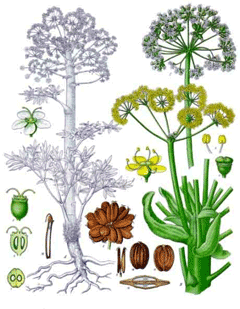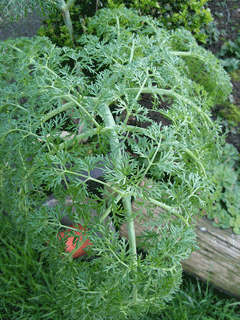 |
|
http://commons.wikimedia.org/wiki/File:Koeh-061.jpg |
 |
| http://flickr.com/photos/25530030%40N02 |
Translate this page:
Summary
Physical Characteristics

 Ferula_assa-foetida is a PERENNIAL growing to 2 m (6ft) by 1.5 m (5ft).
Ferula_assa-foetida is a PERENNIAL growing to 2 m (6ft) by 1.5 m (5ft).
See above for USDA hardiness. It is hardy to UK zone 8. It is in flower in July. The species is hermaphrodite (has both male and female organs) and is pollinated by Insects. The plant is self-fertile.
Suitable for: light (sandy), medium (loamy) and heavy (clay) soils and prefers well-drained soil. Suitable pH: mildly acid, neutral and basic (mildly alkaline) soils. It cannot grow in the shade. It prefers dry or moist soil.
UK Hardiness Map
US Hardiness Map
Synonyms
Ferula foetida. Ferula hooshee
Plant Habitats
Edible Uses
Leaves and young shoots - cooked as a vegetable[2, 4, 177, 183]. The plant has a foetid odour, but this disappears when it is boiled[2]. The cabbage-like folded heads are eaten raw as a delicacy[183]. Root - cooked[2, 4]. It needs to be steeped in order to remove a bitterness[74]. A starch extracted from the roots is used to make a porridge[74]. A gum-resin from the root is used as a food flavouring[171]. It is an essential ingredient of Worcester sauce, it is also used to flavour a wide range of dishes and drinks[183]. It is popular in natural food cuisine as a garlic substitute[183]. The resin obtained from this plant is probably the foulest-smelling of all herbs, with a sulphurous garlic-like odour[7, 238]. It is so nauseating to some people that it has been nicknamed 'dung of the devil'[7]. However, in judicious quantities it gives a surprisingly pleasant flavour to many foods[238].
References More on Edible Uses
Medicinal Uses
Plants For A Future can not take any responsibility for any adverse effects from the use of plants. Always seek advice from a professional before using a plant medicinally.
Asafoetida is a very effective medicinal herb that acts mainly on the digestive system, cleansing and strengthening the gastro-intestinal tract[238]. It is much used in the Ayurvedic tradition[238]. The gum-resin contains a volatile oil that is as persistent in aroma as garlic. They leave the body via the respiratory system and aid the coughing up of congested mucous[254]. The pungently flavoured gum-resin that is obtained from the root is alterative, anthelmintic, antiperiodic, antispasmodic, carminative, deobstruent, deodorant, expectorant, laxative, sedative and stomachic[7, 21, 176, 218]. It is used in the treatment of simple digestive problems such as wind, bloating, indigestion and constipation, and also for respiratory problems such as bronchitis, bronchial asthma and whooping cough[254]. It is also used as a circulatory stimulant, lowering blood pressure and thinning the blood[7, 21, 165, 176, 254]. The resin has a synergistic effect on other herbal preparations such as camphor, valerian and nux-vomica[7]. It is used in tincture as a mild cardio-tonic[7]. As an aphrodisiac [301]. See below under 'Uses notes' for details on harvesting the resin.
References More on Medicinal Uses
The Bookshop: Edible Plant Books
Our Latest books on Perennial Plants For Food Forests and Permaculture Gardens in paperback or digital formats.

Edible Tropical Plants
Food Forest Plants for Hotter Conditions: 250+ Plants For Tropical Food Forests & Permaculture Gardens.
More

Edible Temperate Plants
Plants for Your Food Forest: 500 Plants for Temperate Food Forests & Permaculture Gardens.
More

More Books
PFAF have eight books available in paperback and digital formats. Browse the shop for more information.
Shop Now
Other Uses
A gum-resin is obtained from incisions in the roots and rhizomes[114]. The stem is removed at the end of the growing season, the root uncovered and a thin slice removed[74]. Another report says that the stem is removed as the plant starts to flower[238]. The gum exudes and hardens and a fresh slice is then made[74]. The gum should be stored in an air-tight container to prevent its strong flavour contaminating nearby substances[238]. The gum is a source of an essential oil which has medicinal properties and is also used as a food flavouring and in perfumery[46, 57, 61].
Special Uses
References More on Other Uses
Cultivation details
Succeeds in most soils[1]. Prefers a deep fertile soil in a sunny position[200]. This species is not hardy in the colder areas of the country, it tolerates temperatures down to between -5 and -10°c[200]. Plants have a long taproot and are intolerant of root disturbance[200]. They should be planted into their final positions as soon as possible. Monocarpic, the plant takes some years before it flowers and dies after flowering[74]. In Britain, the plants usually flower after about 5 years[238]. The whole plant, especially when bruised, has an unpleasant smell like stale fish[245].
References Carbon Farming Information and Carbon Sequestration Information
Temperature Converter
Type a value in the Celsius field to convert the value to Fahrenheit:
Fahrenheit:
The PFAF Bookshop
Plants For A Future have a number of books available in paperback and digital form. Book titles include Edible Plants, Edible Perennials, Edible Trees,Edible Shrubs, Woodland Gardening, and Temperate Food Forest Plants. Our new book is Food Forest Plants For Hotter Conditions (Tropical and Sub-Tropical).
Shop Now
Plant Propagation
Seed - best sown as soon as the seed is ripe in a greenhouse in autumn[1]. Otherwise sow in April in a greenhouse. Prick out the seedlings into individual pots as soon as they are large enough to handle. Plant them out into their permanent positions whilst still small because the plants dislike root disturbance[1]. Give the plants a protective mulch for at least their first winter outdoors. Division in autumn. This may be inadvisable due to the plants dislike of root disturbance.
Other Names
If available other names are mentioned here
Native Range
TEMPERATE ASIA: Iran (south)
Weed Potential
Right plant wrong place. We are currently updating this section.
Please note that a plant may be invasive in one area but may not in your area so it’s worth checking.
Conservation Status
IUCN Red List of Threatened Plants Status :

Growth: S = slow M = medium F = fast. Soil: L = light (sandy) M = medium H = heavy (clay). pH: A = acid N = neutral B = basic (alkaline). Shade: F = full shade S = semi-shade N = no shade. Moisture: D = dry M = Moist We = wet Wa = water.
Expert comment
Author
L.
Botanical References
74200
Links / References
For a list of references used on this page please go here
Readers comment
© 2010, Plants For A Future. Plants For A Future is a charitable company limited by guarantee, registered in England and Wales. Charity No. 1057719, Company No. 3204567.